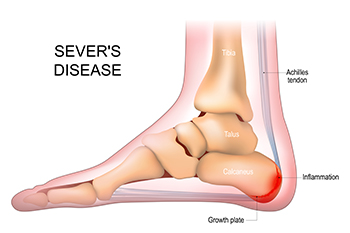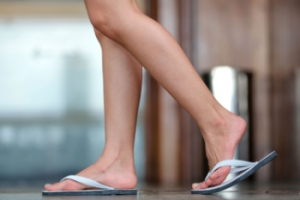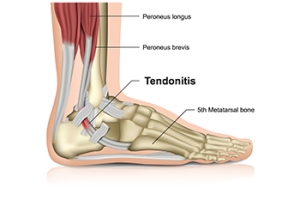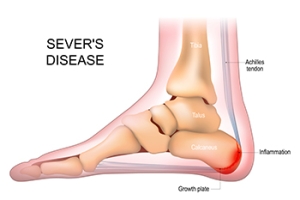Blogs

Negatives of Wearing Flip Flops

Flip-flops, while convenient and casual, are not ideal for foot health. Their lack of arch support and cushioning can lead to issues like foot pain, poor posture, and increased risk of injury. The minimal support may worsen conditions like plantar fasciitis and contribute to misalignment of the feet. Flip-flops also offer little protection from sharp objects or uneven surfaces, making them unsuitable for extended walking or physical activities. They are best worn for brief periods in low-risk environments, such as the poolside or beach, where minimal foot protection is needed. For daily wear or activities that involve prolonged standing or walking, opt for footwear that provides proper arch support and cushioning to promote overall foot health and comfort. Foot conditions may develop when flip flops are frequently worn. If this applies to you, it is suggested that you consult a podiatrist for treatment and who can guide you toward more appropriate shoe choices.
Flip-flops are not always the best choice of footwear. If you have any concerns about your feet or ankles, contact Dr. Dean D. Hinners from Illinois. Our doctor will assist you with all of your foot and ankle needs.
Flip-Flops and Feet
When the weather starts warming up, people enjoy wearing flip-flops. Flip-flops are comfortable, stylish, and easy to slip on and off; they're perfect for any summer beach goer. However, these shoes can cause harm to the feet.
How Can Flip-Flops Affect Me Long-Term?
- Ankle problems
- Hip problems
- Lower back problems
- Pain in the balls of the feet
- Problems with foot arches
- Changes in the way you walk
Are There Injuries Associated with Flip-Flops?
Yes. Since flip-flops are relatively weak and do not provide the same amount of support as sneakers, people who wear flip-flops regularly are more susceptible to injuries. On top of that, the open nature of the shoe makes your feet more prone to other problems, such as cuts and even infections. Common injuries and ailments include:
- Sprained ankles
- Blisters
- Infections
- Cuts and Scrapes
I like Wearing Flip-Flops. Are There Safe Alternatives?
When buying flip-flops, try to find ones that have sturdy soles and that are made of high-quality materials that will support for your feet. These flip-flops will cost more but will also last longer as a result.
If you have any questions please feel free to contact one of our offices located in Metropolis and Eldorado, IL . We offer the newest diagnostic and treatment technologies for all your foot and ankle needs.
Flip Flops and Your Feet
When the weather heats up, you may want to start wearing flip-flops. However, it has been proven that these are not the ideal shoes in terms of preserving the health of your feet.
Flip flops are known to expose your feet to different types of bacteria and fungal infections. When you wear your flip flops in public, you are exposing them to staphylococcus which is a skin-irritating bacterium. Athlete’s foot is also highly contagious and can be spread when you walk around nearly-barefoot.
Another harmful effect of wearing flip-flops is that they develop blisters on the feet. This is because the thin strap rubs against the skin with each step taken. Unfortunately, when blisters pop, they cause you to be more vulnerable to pathogens you pick up by having your feet exposed.
These shoes may also cause “shooting pains”. If you have flat feet, you need arch support to keep your knees, hips, and back in alignment. If you wear flat shoes, your joints are forced to compensate which can cause injuries throughout the body.
If you constantly wear flip-flops, you should avoid doing so as they can lead to many problems for your feet. If you are experiencing any of these foot issues, you should seek help from a podiatrist right away.
Minimally Invasive Achilles Tendon Surgery
 The Achilles tendon, the strongest tendon in the body, connects the calf muscles to the heel bone and is important for walking, running, and jumping. Achilles tendon injuries, such as ruptures, often result from sudden increases in activity or trauma. Conservative treatment for Achilles tendon injuries includes rest, compression, and elevation, in addition to immobilization with a cast or brace to allow natural healing. This approach is typically recommended for less severe injuries or for patients who may not be suitable candidates for surgery. Minimally invasive Achilles tendon repair surgery involves making small incisions to stitch the torn ends of the tendon together. This method reduces the risk of infection, minimizes scarring, and often leads to faster recovery times compared to traditional open surgery. Choosing between conservative treatment and surgery depends on the injury's severity, the patient’s activity level, and overall health. If you have injured your Achilles tendon, it is strongly suggested that you schedule an appointment with a podiatrist to help you determine the best course of treatment.
The Achilles tendon, the strongest tendon in the body, connects the calf muscles to the heel bone and is important for walking, running, and jumping. Achilles tendon injuries, such as ruptures, often result from sudden increases in activity or trauma. Conservative treatment for Achilles tendon injuries includes rest, compression, and elevation, in addition to immobilization with a cast or brace to allow natural healing. This approach is typically recommended for less severe injuries or for patients who may not be suitable candidates for surgery. Minimally invasive Achilles tendon repair surgery involves making small incisions to stitch the torn ends of the tendon together. This method reduces the risk of infection, minimizes scarring, and often leads to faster recovery times compared to traditional open surgery. Choosing between conservative treatment and surgery depends on the injury's severity, the patient’s activity level, and overall health. If you have injured your Achilles tendon, it is strongly suggested that you schedule an appointment with a podiatrist to help you determine the best course of treatment.
Foot surgery is sometimes necessary to treat a foot ailment. To learn more, contact Dr. Dean D. Hinners of Illinois. Our doctor will assist you with all of your foot and ankle needs.
When Is Surgery Necessary?
Foot and ankle surgery is generally reserved for cases in which less invasive, conservative procedures have failed to alleviate the problem. Some of the cases in which surgery may be necessary include:
- Removing foot deformities like bunions and bone spurs
- Severe arthritis that has caused bone issues
- Cosmetic reconstruction
What Types of Surgery Are There?
The type of surgery you receive will depend on the nature of the problem you have. Some of the possible surgeries include:
- Bunionectomy for painful bunions
- Surgical fusion for realignment of bones
- Neuropathy decompression surgery to treat nerve damage
Benefits of Surgery
Although surgery is usually a last resort, it can provide more complete pain relief compared to non-surgical methods and may allow you to finally resume full activity.
Surgical techniques have also become increasingly sophisticated. Techniques like endoscopic surgery allow for smaller incisions and faster recovery times.
If you have any questions please feel free to contact one of our offices located in Metropolis and Eldorado, IL . We offer the newest diagnostic and treatment technologies for all your foot and ankle needs.
Foot Surgery
In most cases, foot surgery is often chosen as the last available option for conditions that have otherwise been unsuccessfully treated. Surgery may be necessary for several reasons, including the removal of foot deformities (e.g. bone spurs or bunions), arthritis problems, reconstruction due to injury, and congenital malformations (e.g. club foot or flat feet). Regardless of one’s age, foot surgery may be the only successful option for treatment for certain conditions.
The type of surgery one undergoes depends on the type of foot condition the patient has. For the removal of a bunion growth, a bunionectomy is necessary. If the bones in the feet need to be realigned or fused together, a surgical fusion of the foot is needed. For pain or nerve issues, a patient may require surgery in which the tissues surrounding the painful nerve are removed. Initially, less invasive treatments are generally attempted; surgery is often the last measure taken if other treatments are unsuccessful.
While in many cases surgery is often deemed as the final resort, choosing surgery comes with certain benefits. The associated pain experienced in relation to the particular condition is often relieved with surgery, allowing patients to quickly resume daily activities. The greatest benefit, however, is that surgery generally eliminates the problem immediately.
Podiatry history has shown that foot treatments continue to evolve over time. In the field of foot surgery, endoscopic surgery is just one of the many advanced forms of surgery. As technology vastly improves so too will the various techniques in foot surgery, which already require smaller and smaller incisions with the use of better and more efficient tools. Thanks to such innovations, surgery is no longer as invasive as it was in the past, allowing for faster and easier recoveries.
What is a High Ankle Sprain?
 A high ankle sprain, also known as a syndesmotic sprain, involves injury to the ligaments connecting the tibia and fibula above the ankle joint. Unlike common ankle sprains affecting the ligaments on the outer side of the ankle, high ankle sprains result from a twisting or rotational force, often occurring during sports involving sudden changes in direction. Symptoms include pain above the ankle, swelling, bruising, and difficulty in bearing weight. Diagnosis typically involves a physical examination and imaging tests like X-rays or MRI scans to assess the extent of ligament damage and to ensure there are no associated fractures. Treatment typically starts with rest, compression, and elevation. Severe cases may require immobilization with a cast or boot and, in some instances, surgery to repair torn ligaments. Recovery can be longer than a typical ankle sprain, ranging from several weeks to a few months, depending on the severity and treatment approach. If you believe you may have endured a high ankle sprain, it is suggested that you schedule an appointment with a podiatrist for a proper diagnosis and treatment.
A high ankle sprain, also known as a syndesmotic sprain, involves injury to the ligaments connecting the tibia and fibula above the ankle joint. Unlike common ankle sprains affecting the ligaments on the outer side of the ankle, high ankle sprains result from a twisting or rotational force, often occurring during sports involving sudden changes in direction. Symptoms include pain above the ankle, swelling, bruising, and difficulty in bearing weight. Diagnosis typically involves a physical examination and imaging tests like X-rays or MRI scans to assess the extent of ligament damage and to ensure there are no associated fractures. Treatment typically starts with rest, compression, and elevation. Severe cases may require immobilization with a cast or boot and, in some instances, surgery to repair torn ligaments. Recovery can be longer than a typical ankle sprain, ranging from several weeks to a few months, depending on the severity and treatment approach. If you believe you may have endured a high ankle sprain, it is suggested that you schedule an appointment with a podiatrist for a proper diagnosis and treatment.
Ankle sprains are common but need immediate attention. If you need your feet checked, contact Dr. Dean D. Hinners from Illinois. Our doctor can provide the care you need to keep you pain-free and on your feet.
How Does an Ankle Sprain Occur?
Ankle sprains take place when the ligaments in your ankle are torn or stretched beyond their limits. There are multiple ways that the ankle can become injured, including twisting or rolling over onto your ankle, putting undue stress on it, or causing trauma to the ankle itself.
What Are the Symptoms?
- Mild to moderate bruising
- Limited mobility
- Swelling
- Discoloration of the skin (depending on severity)
Preventing a Sprain
- Wearing appropriate shoes for the occasion
- Stretching before exercises and sports
- Knowing your limits
Treatment of a Sprain
Treatment of a sprain depends on the severity. Many times, people are told to rest and remain off their feet completely, while others are given an air cast. If the sprain is very severe, surgery may be required.
If you have suffered an ankle sprain previously, you may want to consider additional support such as a brace and regular exercises to strengthen the ankle.
If you have any questions please feel free to contact one of our offices located in Metropolis and Eldorado, IL . We offer the newest diagnostic and treatment technologies for all your foot and ankle needs.
Ankle Sprains
Ankle sprains occur when ligaments that support the ankle stretch beyond their limits and tear. These types of injuries are very common and can occur in people of all ages. Sprains may range from mild to severe, depending on how much damage is done to the ligaments. If a sprain goes untreated, a more severe sprain may occur which can further damage the ankle. Repeated ankle sprains can lead to chronic ankle pain.
There are some risk factors that can increase your risk of suffering a sprained ankle. Those who participate in sports, walk on uneven surfaces, have a prior ankle injury, are in poor physical condition, or wear improper shoes are more likely to get a sprained ankle.
There are a few symptoms to look out for if you suspect you are suffering from a sprained ankle. Some common symptoms are swelling, bruising, tenderness, and instability of the ankle. In cases where the tearing of the ligaments is severe, there may be a “popping” sound when the strain occurs.
The RICE method is proven to be effective in treating ankle sprains. RICE stands for Rest, Ice, Compression, and Elevation. Rest is important for treatment, especially within the first 24 to 48 hours. You should also ice your sprained ankle for the first 48 hours for 20 minutes at a time. A small piece of cloth should be placed between the ice and the affected area. For the compression step, you should wear a brace that is snug, but not too tight that it cuts off circulation. When choosing a brace, be sure to choose one that is suitable for the type of ankle sprain you have. Lastly, you should elevate your foot above the heart as often as possible.
After you treat a sprain, you should go through rehabilitation to prevent the injury from occurring again. There are three phases to the rehab process. The first phase involves resting, protecting, and reducing the swelling of the injury. The second phase consists of restoring the ankle’s flexibility, range of motion, and strength. The third phase consists of slowly returning to activity and maintenance exercises.
If you suspect you have an ankle sprain, you shouldn’t hesitate to consult with your podiatrist. Your podiatrist will be able to give you a proper diagnosis and a suitable treatment option for your condition.
Symptoms and Relief From Sever’s Disease

Sever's disease, also known as calcaneal apophysitis, is a common condition affecting children and adolescents during growth spurts. It involves inflammation of the growth plate in the heel bone, typically occurring in active children aged eight to 14. Symptoms can include heel pain that worsens with activity, limping, and tenderness when pressing on the back of the heel. Factors contributing to Sever's disease include repetitive stress from sports activities like running and jumping, as well as tight Achilles tendons or flat feet. Finding relief involves reducing activity levels that exacerbate symptoms, using heel cushions or orthotic inserts to support the heel, and performing stretching exercises to improve flexibility in the calf muscles and Achilles tendon. Wearing proper footwear with adequate cushioning and support can also alleviate discomfort. If your child has heel pain and enjoys participating in sporting activities, it is suggested that you consult a podiatrist who can provide an accurate diagnosis and treatment.
Sever's disease often occurs in children and teens. If your child is experiencing foot or ankle pain, see Dr. Dean D. Hinners from Illinois. Our doctor can treat your child’s foot and ankle needs.
Sever’s Disease
Sever’s disease is also known as calcaneal apophysitis, which is a medical condition that causes heel pain I none or both feet. The disease is known to affect children between the ages of 8 and 14.
Sever’s disease occurs when part of the child’s heel known as the growth plate (calcaneal epiphysis) is attached to the Achilles tendon. This area can suffer injury when the muscles and tendons of the growing foot do not keep pace with bone growth. Therefore, the constant pain which one experiences at the back of the heel will make the child unable to put any weight on the heel. The child is then forced to walk on their toes.
Symptoms
Acute pain – Pain associated with Sever’s disease is usually felt in the heel when the child engages in physical activity such as walking, jumping and or running.
Highly active – Children who are very active are among the most susceptible in experiencing Sever’s disease, because of the stress and tension placed on their feet.
If you have any questions, please feel free to contact one of our offices located in Metropolis and Eldorado, IL . We offer the newest diagnostic and treatment technologies for all your foot and ankle injuries.
Sever's Disease
Sever’s disease, also known as calcaneal apophysitis is a common bone disorder that occurs during childhood. The disease is defined as an inflammation of the growth plate in the heel. When a child has a growth spurt, his heel bone grows faster than the muscles, tendons, and ligaments in his leg. This disease is a result of overuse. The people who are most likely to be affected by this disease are children who are in a growth spurt, especially boys who are from the ages of 5 to 13 years old. 60% of children with Sever’s disease have both heels involved.
Symptoms of this disease are heel pain that intensifies during running and jumping activities. The pain is typically localized to the posterior part of the heel. Symptoms may be severe, and they can easily interfere with daily activities. Children who play soccer, baseball, and basketball are more likely to develop Sever’s disease.
Your doctor will diagnose your child based on his or her symptoms, x-rays are generally not helpful in diagnosing this disease. Your doctor may examine both heels and ask your child questions about his or her activity level in sports. Your doctor may then use the squeeze test on your child’s heel to see if there is any pain. Nevertheless, some doctors might still use x-rays to rule out any other issues such as fractures, infections, and tumors.
Sever’s disease can be prevented by maintaining good flexibility while your child is growing. Another prevention method is to wear good-quality shoes that have firm support and a shock-absorbent sole. Sever’s disease can be treated by ceasing any activity that causes heel pain. You should apply ice to the injured heel for 20 minutes 3 times a day. Additionally, orthotics should be used for children who have high arches, flat feet, or bowed legs.
If you suspect your child has Sever’s disease, you should make an appointment with your podiatrist to have his or her foot examined. Your doctor may recommend nonsteroidal anti-inflammatory drugs (NSAIDs), such as ibuprofen or naproxen to relieve pain. In more severe cases, your child may need a cast to rest his or her heel. Fortunately, Sever’s disease does not cause long-term foot problems. After treatment, your child should start to feel better within two weeks to two months.
Effective Strategies for Relieving Gout Pain

Gout is a form of arthritis characterized by sudden, severe attacks of pain, redness, and swelling in joints, often caused by an excess of uric acid in the blood. Relieving gout pain involves a combination of medication and lifestyle changes. Nonsteroidal anti-inflammatory drugs, corticosteroids, and colchicine can help reduce inflammation and alleviate pain. Staying well-hydrated by drinking plenty of water can help to flush uric acid from the body, potentially preventing future attacks. Resting the affected joint and keeping it elevated can also provide relief. Dietary changes, such as reducing intake of purine-rich foods like red meat, shellfish, and alcohol, may help to lower uric acid levels. Consuming cherries or cherry juice has been shown to reduce gout flare-ups. Maintaining a healthy weight through regular exercise and a balanced diet can further help manage gout symptoms. Gout can severely hinder daily life. If you have had one or more gout attacks, it is strongly suggested that you are under the care of a podiatrist who can offer you effective relief and treatment strategies.
Gout is a foot condition that requires certain treatment and care. If you are seeking treatment, contact Dr. Dean D. Hinners from Illinois. Our doctor will treat your foot and ankle needs.
What Is Gout?
Gout is a type of arthritis caused by a buildup of uric acid in the bloodstream. It often develops in the foot, especially the big toe area, although it can manifest in other parts of the body as well. Gout can make walking and standing very painful and is especially common in diabetics and the obese.
People typically get gout because of a poor diet. Genetic predisposition is also a factor. The children of parents who have had gout frequently have a chance of developing it themselves.
Gout can easily be identified by redness and inflammation of the big toe and the surrounding areas of the foot. Other symptoms include extreme fatigue, joint pain, and running high fevers. Sometimes corticosteroid drugs can be prescribed to treat gout, but the best way to combat this disease is to get more exercise and eat a better diet.
If you have any questions please feel free to contact one of our offices located in Metropolis and Eldorado, IL . We offer the newest diagnostic and treatment technologies for all your foot and ankle needs.







